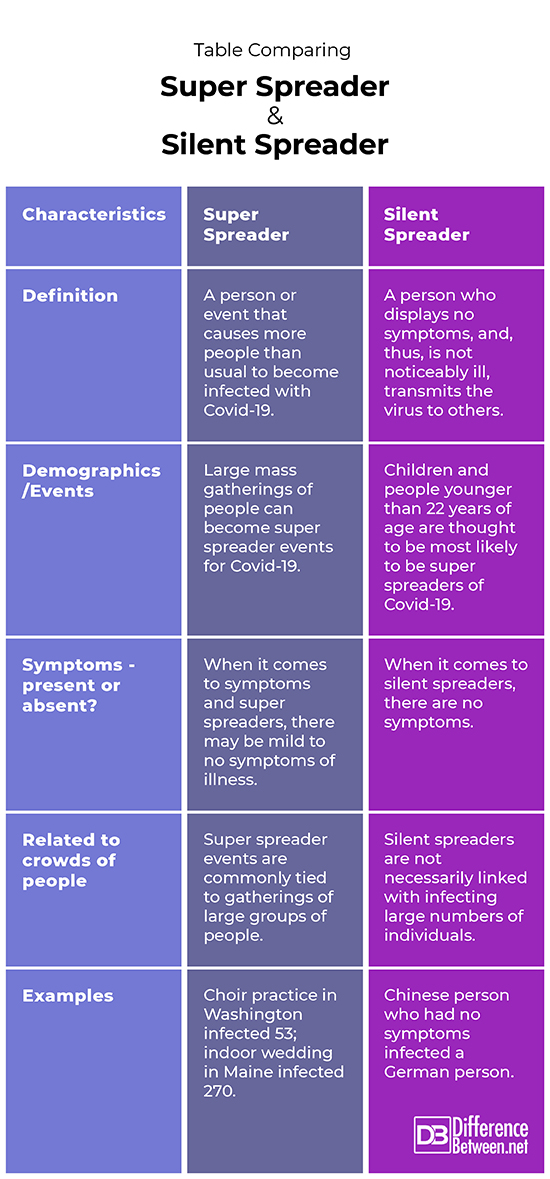Difference Between Super Spreader and Silent Spreader
A super spreader is an individual who infects more people than usual with Covid-19. A silent spreader is an individual who has Covid-19, is asymptomatic, yet is still able to transmit Covid-19 to other people.

What is Super Spreader
Definition:
A super spreader is someone who infects a larger than normal number of people with a contagious disease; today the term is often used when referring to Covid-19. The term can also be applied to an event which acts to amplify the spread of the virus due to large crowds of people being present.
Super spreader demographics/features:
Super spreader events are typically large gatherings of people indoors where ventilation is inadequate. Activities which involve singing also increase the likelihood of contagion as droplets are more easily expelled from an infected person.
Example of a super spreader event:
A choir practice in Washington resulted in 53 cases of Covid-19 among the 60 people who attended the practice. Another example was an indoor wedding that took part in Maine, and resulted in 270 cases of Covid-19.

What is Silent Spreader?
Definition:
A silent spreader is an individual who shows no symptoms of being infected with Covid-19 and does not feel ill at all but still infects other people with the virus.
Silent spreader demographics/features:
Children and individuals younger than 22 are thought to be important as silent spreaders of coronavirus because they carry high loads of the virus. Many may also have mild symptoms or be asymptomatic. For these reasons, these age groups are thought to be important as silent spreaders of Covid-19.
Example of a silent spreader event:
A patient who tested positive for Covid-19 in Germany had only been in contact with an individual from China who appeared healthy and who had no symptoms of illness at all. The person from China only become noticeably ill with symptoms days after the German patient had become ill, and they were later determined to have the virus. This was a case of a silent spreader event of Covid-19.
Difference between Super spreader and Silent spreader
Definition
A super spreader is an individual person or event that causes more people than usual to become infected with Covid-19. A silent spreader is a person who displays no symptoms, is not noticeably ill, yet still transmits the virus to others.
Demographics/Events
Large mass gatherings of people can become super spreader events for Covid-19. Children and people younger than 22 years of age are thought to be most likely to be super spreaders of Covid-19.
Symptoms – present or absent?
When it comes to symptoms and super spreaders, there may be mild to no symptoms of illness. When it comes to silent spreaders, there are no symptoms.
Related to crowds of people
Super spreader events are commonly tied to gatherings of large groups of people. Silent spreaders are not necessarily associated with infecting large numbers of individuals.
Examples
Examples of super spreader events included the choir practice in Washington that infected 53 people and an indoor wedding in Maine that infected 270 people with Covid. An example of a silent spreader was a record of a Chinese person who had no symptoms, and did not know she had Covid, who unknowingly infected a German person.
Table comparing Super spreader and Silent spreader

Summary of Super spreader Vs. Silent spreader
- Super spreader and silent spreader are both terms referring to situations when Covid-19 is transmitted among people.
- The term super spreader can be used to refer to a person or even an event where a large number of people are infected with Covid-19.
- The term silent spreader is limited to people who have no symptoms and often, unknowingly, transmit Covid-19 to other people.
- Both super spreaders and silent spreaders are partly why Covid-19 has spread so rapidly to every part of the world, infecting millions.
Other FAQ
What is the most common way COVID-19 is transmitted?
Covid-19 is most commonly transmitted from person to person via respiratory droplets or aerosolized particles.
What precautions can I take to minimize the spread of COVID-19?
Practicing good and frequent hand washing with soap and water and avoiding touching surfaces can help reduce the spread of the virus. In addition, social distancing and wearing a mask can also reduce transmission of the virus among individuals.
Can you infect others even if you aren’t showing symptoms of COVID-19?
It is possible to infect people with Covid-19 even if you are asymptomatic, which is one reason why the virus spreads so rapidly. People may be infected with Covid-19 and not know that they are infected.
How long is a person with COVID-19 contagious before showing symptoms?
A person is able to transmit the virus even 48 hours before the initial symptoms of the illness appear.
How long do COVID-19 symptoms take to appear after exposure?
Symptoms of Covid exposure can first appear anywhere from two days to two weeks after exposure to the virus.
- Difference Between Rumination and Regurgitation - June 13, 2024
- Difference Between Pyelectasis and Hydronephrosis - June 4, 2024
- Difference Between Cellulitis and Erysipelas - June 1, 2024
Search DifferenceBetween.net :
Leave a Response
References :
[0]Cave, Emma. "COVID-19 super-spreaders: definitional quandaries and implications." Asian bioethics review 12 (2020): 235-242.
[1]Huang, Pien. "What we know about the silent spreaders of COVID-19." NPR, 2020,https://www.npr.org/sections/goatsandsoda/2020/04/13/831883560/can-a-coronavirus-patient-who-isnt-showing-symptoms-infect-others
[2]Reich, Ofir, Guy Shalev, and Tom Kalvari. "Modeling COVID-19 on a network: super-spreaders, testing and containment." MedRxiv (2020).
[3]Image credit: https://pixabay.com/illustrations/bar-corona-local-super-spreader-5348957/
[4]Image credit: https://pixabay.com/illustrations/corona-super-spreader-virus-5380032/
